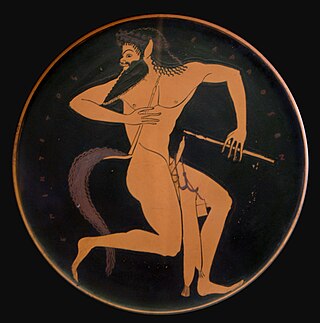
In Greek mythology, a satyr, also known as a silenus or silenos, and selini (plural), is a male nature spirit with ears and a tail resembling those of a horse, as well as a permanent, exaggerated erection. Early artistic representations sometimes include horse-like legs, but, by the sixth century BC, they were more often represented with human legs. Comically hideous, they have mane-like hair, bestial faces, and snub noses and they always are shown naked. Satyrs were characterized by their ribaldry and were known as lovers of wine, music, dancing, and women. They were companions of the god Dionysus and were believed to inhabit remote locales, such as woodlands, mountains, and pastures. They often attempted to seduce or rape nymphs and mortal women alike, usually with little success. They are sometimes shown masturbating or engaging in bestiality.

In Greek mythology, Silenus was a companion and tutor to the wine god Dionysus. He is typically older than the satyrs of the Dionysian retinue (thiasos), and sometimes considerably older, in which case he may be referred to as a Papposilenus. The plural sileni refers to the mythological figure as a type that is sometimes thought to be differentiated from a satyr by having the attributes of a horse rather than a goat, though usage of the two words is not consistent enough to permit a sharp distinction. Silenus presides over other daemones and is related to musical creativity, prophetic ecstasy, drunken joy, drunken dances and gestures.

Praxiteles of Athens, the son of Cephisodotus the Elder, was the most renowned of the Attica sculptors of the 4th century BC. He was the first to sculpt the nude female form in a life-size statue. While no indubitably attributable sculpture by Praxiteles is extant, numerous copies of his works have survived; several authors, including Pliny the Elder, wrote of his works; and coins engraved with silhouettes of his various famous statuary types from the period still exist.

The faun is a half-human and half-goat mythological creature appearing in Greek and Roman mythology.
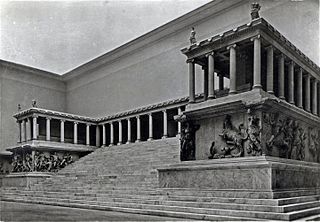
The Pergamon Altar was a monumental construction built during the reign of the Ancient Greek King Eumenes II in the first half of the 2nd century BC on one of the terraces of the acropolis of Pergamon in Asia Minor.
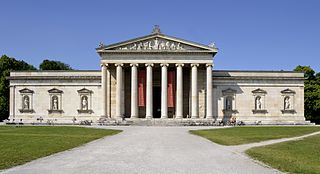
The Glyptothek is a museum in Munich, Germany, which was commissioned by the Bavarian King Ludwig I to house his collection of Greek and Roman sculptures. It was designed by Leo von Klenze in the neoclassical style, and built from 1816 to 1830. Today the museum is a part of the Kunstareal.

The sculpture of ancient Greece is the main surviving type of fine ancient Greek art as, with the exception of painted ancient Greek pottery, almost no ancient Greek painting survives. Modern scholarship identifies three major stages in monumental sculpture in bronze and stone: the Archaic, Classical (480–323) and Hellenistic. At all periods there were great numbers of Greek terracotta figurines and small sculptures in metal and other materials.

The life-size ancient but much restored marble statue known as the Barberini Faun, Fauno Barberini or Drunken Satyr is now in the Glyptothek in Munich, Germany. A faun is the Roman equivalent of a Greek satyr. In Greek mythology, satyrs were human-like male woodland spirits with several animal features, often a goat-like tail, hooves, ears, or horns. Satyrs attended Dionysus.

Classical sculpture refers generally to sculpture from Ancient Greece and Ancient Rome, as well as the Hellenized and Romanized civilizations under their rule or influence, from about 500 BC to around 200 AD. It may also refer more precisely a period within Ancient Greek sculpture from around 500 BC to the onset of the Hellenistic style around 323 BC, in this case usually given a capital "C". The term "classical" is also widely used for a stylistic tendency in later sculpture, not restricted to works in a Neoclassical or classical style.

The study of Roman sculpture is complicated by its relation to Greek sculpture. Many examples of even the most famous Greek sculptures, such as the Apollo Belvedere and Barberini Faun, are known only from Roman Imperial or Hellenistic "copies". At one time, this imitation was taken by art historians as indicating a narrowness of the Roman artistic imagination, but, in the late 20th century, Roman art began to be reevaluated on its own terms: some impressions of the nature of Greek sculpture may in fact be based on Roman artistry.
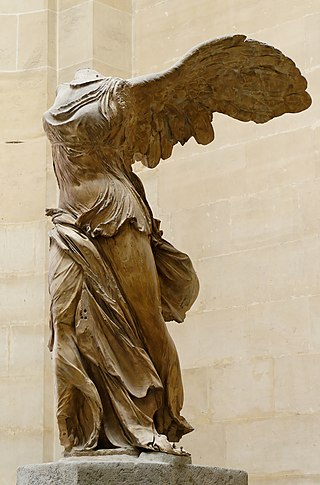
Hellenistic art is the art of the Hellenistic period generally taken to begin with the death of Alexander the Great in 323 BCE and end with the conquest of the Greek world by the Romans, a process well underway by 146 BCE, when the Greek mainland was taken, and essentially ending in 30 BCE with the conquest of Ptolemaic Egypt following the Battle of Actium. A number of the best-known works of Greek sculpture belong to this period, including Laocoön and His Sons, Venus de Milo, and the Winged Victory of Samothrace. It follows the period of Classical Greek art, while the succeeding Greco-Roman art was very largely a continuation of Hellenistic trends.

The Temple of Aphaia or Afea is located within a sanctuary complex dedicated to the goddess Aphaia on the Greek island of Aigina, which lies in the Saronic Gulf. Formerly known as the Temple of Jupiter Panhellenius, the great Doric temple is now recognized as dedicated to the mother-goddess Aphaia. It was a favourite of the Neoclassical and Romantic artists such as J. M. W. Turner. It stands on a c. 160 m peak on the eastern side of the island approximately 13 km east by road from the main port.

Augustus of Prima Porta is a full-length portrait statue of Augustus Caesar, the first emperor of the Roman Empire. The marble statue stands 2.08 metres tall and weighs 1,000 kilograms (2,200 lb). The statue was discovered on April 20, 1863, during archaeological excavations directed by Giuseppe Gagliardi at the Villa of Livia owned by Augustus' third and final wife, Livia Drusilla in Prima Porta. Livia had retired to the villa after Augustus's death in AD 14. The statue was first publicized by the German archeologist G. Henzen and was put into the Bulletino dell'Instituto di Corrispondenza Archaeologica. Carved by expert Greek sculptors, the statue is assumed to be a copy of a lost bronze original displayed in Rome. The Augustus of Prima Porta is now displayed in the Braccio Nuovo of the Vatican Museums. Since its discovery, it has become the best known of Augustus' portraits and one of the most famous sculptures of the ancient world.
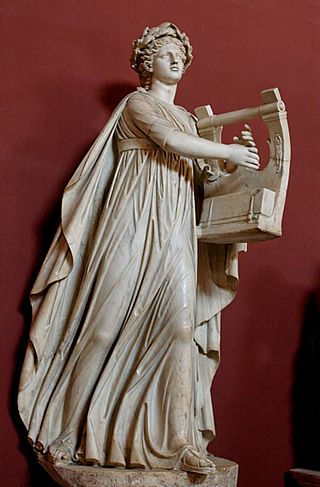
An Apollo Citharoedus, or Apollo Citharede, is a statue or other image of Apollo with a cithara (lyre). Among the best-known examples is the Apollo Citharoedus of the Vatican Museums, a 2nd-century AD colossal marble statue by an unknown sculptor. Apollo is shown crowned with laurel and wearing the long, flowing robe of the Ionic bard. The statue was found in 1774, with seven statues of the Muses, in the ruins of Gaius Cassius Longinus' villa near Tivoli, Italy. The sculptures are preserved in the Hall of the Muses, in the Museo Pio-Clementino of the Vatican Museums.

The Dionysus Sardanapalus is an uncommon Hellenistic-Roman Neo Attic sculpture-type of the god Dionysus, misnamed after the king Sardanapalus. Unlike most contemporary figurations of Dionysus as a lithe youth, the self-consciously archaising god is heavily draped, with an ivy wreath and a long archaic-style beard; probably he bore a thyrsos in a raised right hand, now missing.

The Staatliche Antikensammlungen is a museum in Munich's Kunstareal holding Bavaria's collections of antiquities from Greece, Etruria and Rome, though the sculpture collection is located in the opposite Glyptothek and works created in Bavaria are on display in a separate museum. Ancient Egypt also has its own museum.

Eirene, more commonly known in English as Peace, was one of the Horae, the personification of peace. She was depicted in art as a beautiful young woman carrying a cornucopia, sceptre, and a torch or rhyton. She is said sometimes to be the daughter of Zeus and Themis and sister of Dike and Eunomia. Her Roman equivalent was Pax.

In the burial practices of ancient Rome and Roman funerary art, marble and limestone sarcophagi elaborately carved in relief were characteristic of elite inhumation burials from the 2nd to the 4th centuries AD. At least 10,000 Roman sarcophagi have survived, with fragments possibly representing as many as 20,000. Although mythological scenes have been quite widely studied, sarcophagus relief has been called the "richest single source of Roman iconography," and may also depict the deceased's occupation or life course, military scenes, and other subject matter. The same workshops produced sarcophagi with Jewish or Christian imagery. Early Christian sarcophagi produced from the late 3rd century onwards, represent the earliest form of large Christian sculpture, and are important for the study of Early Christian art.

The Resting Satyr or Leaning Satyr, also known as the Satyr anapauomenos is a statue type generally attributed to the ancient Greek sculptor Praxiteles. Some 115 examples of the type are known, of which the best known is in the Capitoline Museums.

Ancient Greek art stands out among that of other ancient cultures for its development of naturalistic but idealized depictions of the human body, in which largely nude male figures were generally the focus of innovation. The rate of stylistic development between about 750 and 300 BC was remarkable by ancient standards, and in surviving works is best seen in sculpture. There were important innovations in painting, which have to be essentially reconstructed due to the lack of original survivals of quality, other than the distinct field of painted pottery.






















